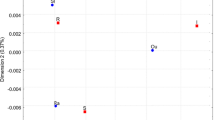Abstract
Municipal wastewater treatment plants are recognized reservoirs of antibiotic-resistant bacteria. Three municipal wastewater treatment plants differing on the dimensions and bio-treatment processes were compared for the loads of amoxicillin-, tetracycline-, and ciprofloxacin-resistant heterotrophic bacteria, enterobacteria, and enterococci in the raw inflow and in the treated effluents. The sewage received by each plant, in average, corresponded to 85,000 inhabitant equivalents (IE), including pretreated industrial effluents (≤30%) in plant activated sludge, 105,000 IE, including pretreated hospital effluents (≤15%) in plant trickling filter, and 2,000 IE, exclusively of domestic sewage, in plant submerged aerated filter. The presence of pretreated industrial effluents or of pretreated hospital sewage in the raw inflow did not imply significantly higher densities (per milliliter or per IE) of antibiotic-resistant bacteria in the raw wastewater. Longer hydraulic residence periods (24 h) corresponded to higher bacterial removal rates than shorter periods (12 and 9 h), although such efficiency did not imply significant average decreases in the antibiotic resistance prevalence of the treated effluent. The bacterial loads in the treated effluent could be ranked according to the treatment efficiency, suggesting that the characteristics of the raw inflow may have less relevance on the quality of the treated wastewater than other aspects, such as the inflow volume, the type of biological treatment, or the hydraulic residence time.


Similar content being viewed by others
References
Baquero F, Martínez JL, Cantón R (2008) Antibiotics and antibiotic resistance in water environments. Curr Opin Biotechnol 19:260–265
Blanch AR, Caplin JL, Iversen A, Kühn I, Manero A, Taylor HD, Vilanova X (2003) Comparison of enterococcal population related to urban and hospital wastewater in various climatic and geographic European regions. J Appl Microbiol 94:994–1002
Costa PM, Vaz-Pires P, Bernardo F (2006) Council Directive 91/271/EEC, of 21 May 1991 concerning urban waste-water treatment. Antimicrobial resistance in Enterococcus spp. isolated in inflow, effluent and sludge from municipal sewage water treatments. Water Res 40:1735–1740
Ferreira da Silva M, Tiago I, Veríssimo A, Boaventura RAR, Nunes OC, Manaia CM (2006) Antibiotic resistance of enterococci and related bacteria in an urban wastewater treatment plant. FEMS Microbiol Ecol 55:322–329
Ferreira da Silva M, Vaz-Moreira I, Gonzalez-Pajuelo M, Nunes OC, Manaia CM (2007) Antimicrobial resistance patterns in Enterobacteriaceae isolated from an urban wastewater treatment plant. FEMS Microbiol Ecol 60:166–176
Forster S, Lappin-Scott HM, Snape JR, Porter J (2003) Rains, drains and active strains: towards online assessment of wastewater bacterial communities. J Microbiol Methods 55:859–864
Gallert C, Fund K, Winter J (2005) Antibiotic resistance of bacteria in raw and biologically treated sewage and in groundwater below leaking sewers. Appl Microbiol Biotechnol 69:106–112
Goñi-Urriza M, Capdepuy M, Arpin C, Raymond N, Caumette P, Quentin C (2000) Impact of an urban effluent on antibiotic resistance of riverine Enterobacteriaceae and Aeromonas spp. Appl Environ Microbiol 66:125–132
Guardabassi L, Lo Fo Wong DMA, Dalsgaard A (2002) The effects of tertiary wastewater treatment on the prevalence of antimicrobial resistant bacteria. Water Res 36:1955–1964
Kim S, Aga DS (2007) Potential ecological and human health impacts of antibiotics and antibiotic-resistant bacteria from wastewater treatment plants. J Toxicol Environ Health B 10:559–573
Kümmerer K (2009a) Antibiotics in the aquatic environment—a review—part II. Chemosphere 75:435–441
Kümmerer K (2009b) Antibiotics in the aquatic environment—a review—part I. Chemosphere 75:417–434
Manaia CM, Novo A, Coelho B, Nunes OC (2010) Ciprofloxacin resistance in domestic wastewater treatment plants. Water Air Soil Pollut 208:335–343
Martínez JL (2009) Environmental pollution by antibiotics and by antibiotic resistance determinants. Environ Pollut 157:2893–2902
McGowan JE Jr (2006) Resistance in nonfermenting gram-negative bacteria: multidrug resistance to the maximum. Am J Med 119(6A):S29–S36
Observatório Nacional de Saúde (2002) Médicos Sentinela (ONSA). http://www.onsa.pt
Paterson DL (2006) Resistance in Gram-negative: Enterobacteriaceae. Am J Med 119(6A):S20–S28
Reinthaler FF, Posch J, Feierl G, Wüst G, Haas D, Ruckenbauer G, Mascher F, Marth E (2003) Antibiotic resistance of E. coli in sewage and sludge. Water Res 37:1685–1690
Servais P, Passerat J (2009) Antimicrobial resistance of fecal bacteria in waters of Seine river watershed (France). Sci Total Environ 408:365–372
Tchobanoglous G, Burton FL, Stensel HD (2003) Wastewater Engineering: Treatment and Reuse, 4th edn. Metcalf & Eddy, Inc, McGraw-Hill, New York
Vilanova X, Manero A, Cerdá-Cuéllar M, Blanch AR (2002) The effect of a sewage treatment plant effluent on the faecal coliforms and enterococci populations of the reception river. J Appl Microbiol 92:210–214
Watkinson AJ, Micalizzi GB, Bates JB, Costanzo SD (2007) Novel method for rapid assessment of antibiotic resistance in Escherichia coli isolates from environmental waters by use of a modified chromogenic agar. Appl Environ Microbiol 7:2224–2229
Acknowledgements
The authors gratefully acknowledge the engineers of the wastewater treatment facilities for their support for samples collection and the COD and BOD5 analyses and the technicians of the Portuguese Environment Agency for heavy metals determinations. This study was financed by Fundação para a Ciência e a Tecnologia (project PTDC/AMB/71236/2006).
Author information
Authors and Affiliations
Corresponding author
Rights and permissions
About this article
Cite this article
Novo, A., Manaia, C.M. Factors influencing antibiotic resistance burden in municipal wastewater treatment plants. Appl Microbiol Biotechnol 87, 1157–1166 (2010). https://doi.org/10.1007/s00253-010-2583-6
Received:
Revised:
Accepted:
Published:
Issue Date:
DOI: https://doi.org/10.1007/s00253-010-2583-6




